My visit was on the occasion of the church's annual festival this past weekend.
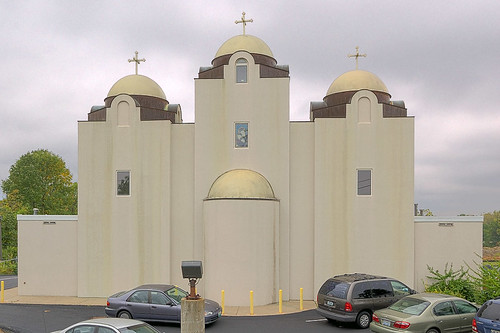
This parish was formed in 1976; the church building dates from 1994 and is in the form of traditional Coptic churches. This church was consecrated by the Patriarch of the Coptic Orthodox Church, Pope Shenouda III. The title ‘Pope’ means papa or dad.
The Copts are Christians of ethnic Egyptian descent. Egypt became Christian at a very early date, and many Christians still live in that country, often in ethnically segregated cities. Coptic Catholics and Coptic Orthodox are often found within the same family.
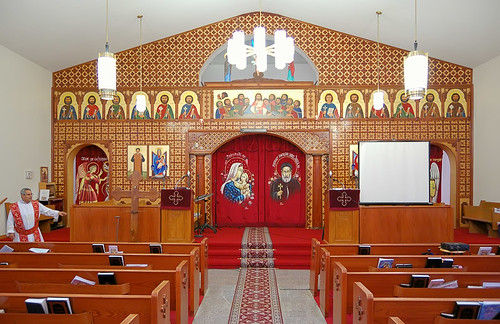
The iconostasis includes icons of the Apostles along the top, with the Last Supper above the veil covering the altar. The altar veil hearkens back to the Holy of Holies at the Jewish Temple in Jerusalem; and under the New Covenant, Our Lord's altar is also covered as a sign of sacredness — but during the Divine Liturgy the veil is pulled back, and God comes out to us. The screening of the sanctuary was also found in Latin Christianity in the Middle Ages.
On the veil is depicted the Blessed Virgin Mary with the Christ Child, and Saint Abraam, who was a Bishop who lived in the early 20th century.
The liturgy here is primarily in English, with portions in Coptic and Arabic, and the Missals, seen here in the pew pockets, are trilingual, as are the hymnals, while the Book of Hours is in English. The church uses the Revised Standard Edition of the scripture, which includes the books of the Greek Septuagint; this translation is in contemporary English, in the tradition of the Douai and King James Bibles. Sunday liturgy is about three hours long.
On the left is Deacon Ramses, who led a tour of the church and kindly answered my questions in great detail. Deacons have a liturgically important rôle, and among their various ranks are Archdeacons, who may substitute for a priest or bishop under extraordinary circumstances.
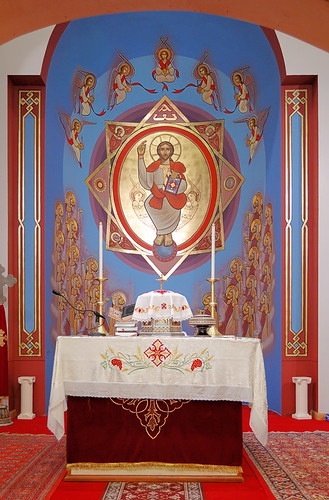
A view of the high altar, with the veil pulled back. In the center of the apse is an icon of Christ Pantocrator, or ruler of all. The priest says Mass towards the liturgical east, which of course is also geographical east.
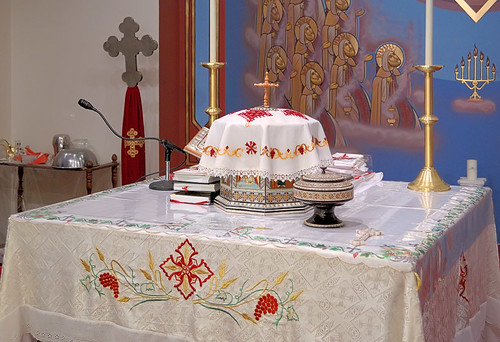
A detail of the high altar. The liturgical vessels are kept in the tabernacle-like container at the center of the altar, while the vessel on the right holds incense.
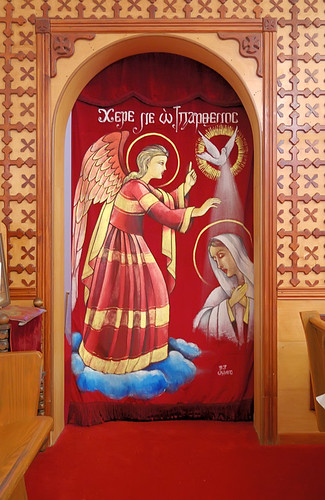
According to the ancient tradition of the church, men and women approach communion separately. Here is the doorway to the men's side of the sanctuary, with a depiction of the Annunciation. On the veil is Coptic script, which is the Greek alphabet with letters added to represent sounds not found in Greek.
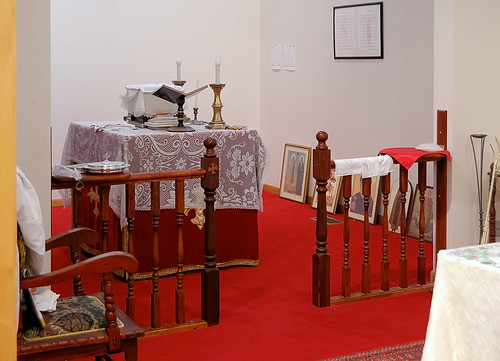
Here is the men's communion rail, located behind the iconostasis. Communion is received under both species separately (that is, not by intinction), while standing. Behind the communion rail is a side-altar; Mass may not be re-offered on a single altar within a nine hour period of time.
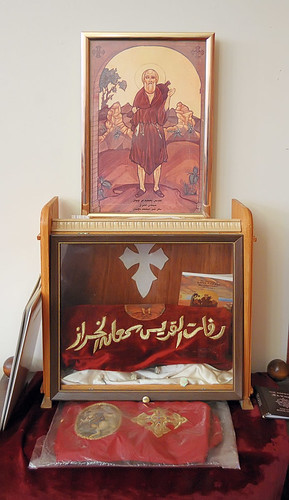
This appears to be a reliquary of Saint Samaan the Tanner.
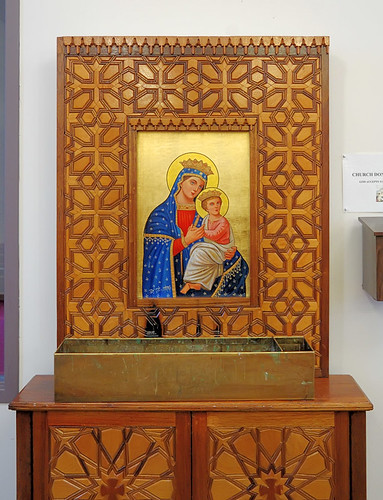
Icon of the Blessed Virgin Mary, who is co-patron of this church, with the Christ Child. The container in front of the icon is filled with sand and is used to place candles.
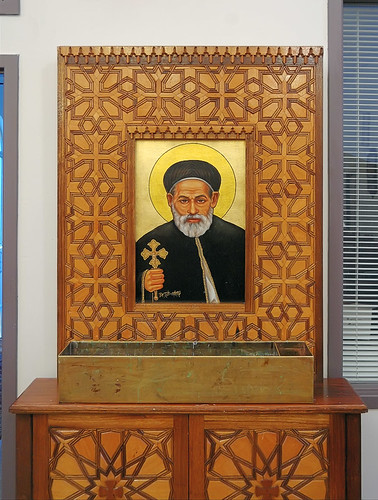
Saint Abraam, the other co-patron of the church.
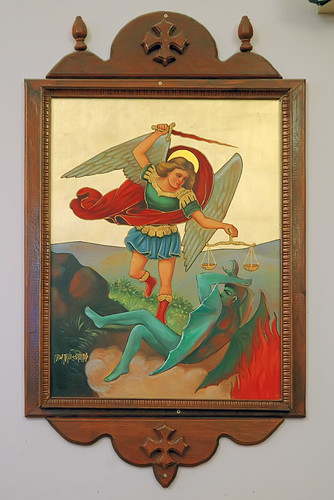
Icon of Saint Michael the Archangel, defeating Satan, who according to the book of Revelation, was in the form of a dragon.

Saint George slaying the dragon; in many churches, this and the icon of Saint Michael are often displayed together.
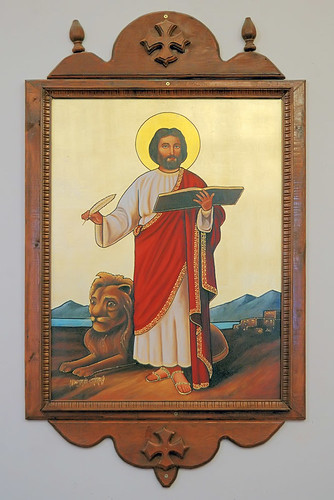
Icon of Saint Mark the Evangelist, apostle to the Egyptians and founder of the Coptic Church.


Very interesting.
ReplyDeleteThis photos, by the way, are just casual handheld snapshots, so there is a bit of noise in the images, as well as some over and under exposure and lack of focus.
ReplyDeleteStill, I feel these are beautiful exposures with just the right amount of sharpening. Good work! What kind of camera are you using?
ReplyDeleteChris,
ReplyDeleteThank you very much!
I use Nikon's cheapest DSLR, the D40, but it still has excellent image quality for this purpose, and had good enough resolution for the 8-1/2 by 11 inch photos in my book, "Catholic St. Louis".
I pay a lot of attention to exposure, and I check all three color channels to avoid color shifts in the highlights.
I sharpened these images at their full size, which is 1000 pixels along the longest edge; Flickr here reduces these images to half that size, and so sometimes produces a bit of over-sharpening. I currently use a very "mathematically correct" sharpening process. It avoids the halos of Unsharp Mask and the noisy artifacts of Smart Sharpen; it also allows me to really juice up the sharpening. Of course, using good quality lenses, and keeping them clean helps a lot.
Hi Mark,
ReplyDeleteI am a member of the St. Mary & St. Abraam Coptic Orthodox Church in St. Louis and came across your web page. Your pictures are really magnificent and present the beauty of our church in a great way. Thank you for posting these pictures and sharing them with everyone. Hope to see you again at the church during the festival next year.
Excelentes fotos.
ReplyDeleteMagnífico blog dedicado a arte.
I lived very close this church in the Boulder Springs Apartment Buildings for 2 years but I was not enough interested to see it, now I have and would like to go there
ReplyDeleteBy the way I really like your postings, good pictures Mark
Angie
Hello, I am looking to come to St. Louis for its law school in WashU. I was hoping Hany, or anyone else, that you could put me in touch with someone I can speak to from the congregation or clergy? I am a Coptic Egyptian from New Jersey.
ReplyDeleteHere is the church’s website. Perhaps you can find someone through this: http://www.stmary-church.com
ReplyDeleteWe St. Louisians should be grateful that we have in our area such a diversity of the Christian experience. This is one great way to experience first hand the glorious Coptic church founded by St. Mark. Soon i hope to visit and attend vespers.
ReplyDeleteI am from NJ here in St. Louis temporarily on a job assignment. I came to this church today through a google search and I was mesmerized by the art and completely encompassed in it. Was too shy to go take a picture and couldn't resist the urge to see if google has pictures of the art in this church. Mesmerizing thank you for posting.
ReplyDelete